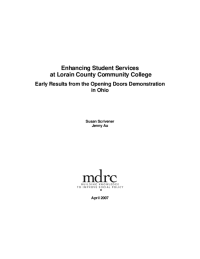Enhancing Student Services at Lorain County Community College
Early Results from the Opening Doors Demonstration in Ohio
Community colleges enroll nearly half of all higher education students nationwide; with relatively low tuition and open admissions policies, they are a vital pathway to better jobs and higher earnings for many individuals. Unfortunately, only about a third of those who entered a community college in 1995-1996 had earned a degree or certificate six years later. Students who are juggling school, work, and family obligations face substantial challenges in completing their education, and inadequate student support services and insufficient financial aid can impede their progress. In 2003, MDRC and a consortium of funders launched the Opening Doors demonstration to test reforms in six community colleges aimed at helping students stay in school and earn credentials.
This report presents early results from the Opening Doors program at Lorain County Community College in Elyria, Ohio, outside Cleveland. The program, which operated from 2003 to 2006, provided enhanced student services and a modest scholarship to participating students for two semesters. Students were assigned to one of a team of advisers, with whom they were expected to meet frequently to discuss academic progress and issues that might affect their schooling. Students also sometimes met with other advisers on the team and a designated contact in the financial aid office. Each adviser worked with no more than 110 students. In contrast, other students at Lorain had access to advising staff as needed at a walk-in center, which employed one adviser for roughly every 1,000 students. Students in the Opening Doors program received a $150 scholarship each semester (for a total of $300), which was paid after required advising sessions. Lorain targeted its program to students whose family income was below 250 percent of the federal poverty level, and who were either incoming freshmen or had completed less than 13 credits and had a history of academic difficulties. Most of the participants were mothers, about half were employed, and their average age was 25 when they entered the study.
MDRC is evaluating Lorain’s program using a random assignment research design. Students were assigned in a lottery-like process either to a program group that received Opening Doors services or to a control group that received Lorain’s standard services. Analysis of transcript data for students who entered the study during its first year — about half the full research sample — shows that:
- Lorain’s Opening Doors program gave students a boost while they received services. Students in the program group were more likely than students in the control group to reenroll in college after one semester. They also registered for and earned more credits.
- The boost ended when the program’s services ended. In the semester after the program ended, academic outcomes for the two research groups were similar.
- However, the positive effects on enrollment during the program gave Opening Doors students a small advantage overall. Results summarizing outcomes for students’ first three semesters in the study show a small increase in the number of semesters enrolled for the program group. There was no difference, however, between the two groups in total credits earned.
While it is too soon to draw final conclusions, Lorain’s early results show that the program improved students’ short-term outcomes but does not yet appear to have had a significant lasting effect. Future reports will present results for the full research sample on a wider array of measures, including degree completion, transfer, employment, and well-being.






